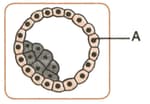Implantation
Implantation: Overview
This topic covers concepts, such as, Cleavage of Zygote, Morula, Implantation & Blastocyst etc.
Important Questions on Implantation
Assertion: Holoblastic cleavage with almost equal sized blastomeres is a characteristic of placental animals.
Reason: Eggs of most mammals, including humans, are of centrolecithal type.
Morula is a developmental stage between two of the following:
The number of cells present in the morula stage is _____. (Write it numerically)
A change in the amount of yolk and its distribution in the egg will not affect
The type of division takes place during zygote cleavage is _____
_____ is the process in which blastocyst is embedded in the endometrium of the uterus.
Fill in the blank with the correct word given in the bracket.
Attachment of embryo to the wall of uterus is known as _____ (implantation/gastrulation).
Right and left sides of an embryo become apparent during ___________.
A blastocyst is a hollow ball, surrounded by a single layer of cells enclosing a cavity called the blastocoel or the cleavage cavity.
Which process of embryonic development is called fractionating process, whether it is cleavage or gastrulation?
Identify the part labelled 'A' from the figure given below.

Embryonic membranes are formed from a layer of cells called _____ of blastula.
Which layer of blastocyst projects into the endometrium and destroys endometrial cells?
cleavage takes place about hours after fertilization.
Cleavage converts zygote into a mass of cells called
Which type of division occurs in cleavage?
Mention whether 'Mitotic or Meiotic' division takes place during the cleavage of zygote.
